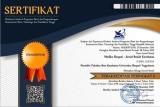APLIKASI MOBILE “MOGIZ†UNTUK MONITORING STATUS GIZI
DOI:
https://doi.org/10.35842/mr.v16i2.478Keywords:
student response, adolescents, nutrition disc, fruit and vegetablesAbstract
“MOGIZ†Mobile Application for Monitoring Nutritional Status
Background: many mobile applications for health have been developed, but only a few have the development process based on user needs. Objective: the purpose of this research is to produce an user friendly, acceptable, and beneficial mobile application for many people. Methods: the MoGiz android application is developed with a user-centered design method using the Java software development kit 8, android studio, visual studio code, and flutter framework. MoGiz consist of six main menus: 1) Measurement method, 2) Check nutritional status, 3) Measurement history, 4) Consultation, 5) Advice, and 6) About MoGiz. In the first menu, user can read articles about how to measure some body parameters correctly and view videos. In the second menu, user can input their weight and height, upper arm circumference, waist and hip circumference and then find out the interpretation. Results: MoGiz has tried to include gamification by giving points to each user activity such as measuring nutritional status, answering quizzes and sharing the results of measuring nutritional status to social media. If the points meet the limit, it can be exchanged for rewards. Conclusion: MoGiz has been developed for various age groups as a guide for the community to assess nutritional status independently. In addition, this application also provides nutrition and health information for user which is expected to encourage people's habits to behave in a healthy and nutritionally balanced manner.
References
World Health Organization. 2020. Coronavirus Disease (COVID-19) Pandemic. Dipetik 8 November, 2020 dari https://www.who.int/emergencies/diseases/novel-coronavirus-
?gclid=Cj0KCQiAy579BRCPARIsAB6QoIb_OKzdIlZjAFBk9Lqvn_HB7p_wMSz
E0zCebzpUI6945DwfunAKMeYaAiamEALw_wcB
Purnamasari D. 2018. The emergence of non-communicable disease in Indonesia. Acta Med Indones-Indones J Intern Med; 50(4): 273-274.
Kemenkes RI. 2018. Riset Kesehatan Dasar Tahun 2018. Jakarta: Balitbangkes.
Wild S, Roglic G, Green A, Sicree R, King H. 2004. Global Prevalence of
Diabetes. Diabetes Care 27: 1047–1053
Ebbeling CB, Pawlak DB, and Ludwig DS. 2002. Childhood obesity: public-health crisis, common sense cure. Lancet, vol.360, no. 9331, pp. 473–482.
Nathan BM and Moran A. 2008. Metabolic complications of obesity in childhood and adolescence: More than just diabetes, Current Opinion in Endocrinology, Diabetes and Obesity, vol. 15, no. 1, pp. 21–29.
Webber L, Kilpi F, Marsh T, Rtveladze K, Brown M, McPherson K. 2012. High rates of obesity and non-communicable disease predicted across Latin America. 7(8): 1-6.
Chaker L, Falla A, Lee SJ, Muka T, Imo D, Jaspers L, et al. 2015. The impact of non-communicable disease on macro-economic productivity: a systematic review. Eur J.Epidemiol. 30(5):357-395.
Bauman, A., Ernst, K., Hayden, M., et al. 2018. Assessing community health: an innovative tool for measuring height and length. Journal of tropical pediatrics, 64:146-150.
Gibson RS. 2005. Principles of Nutritional Assessment. New York: Oxford University Press.
Supariasa IDN, Bakri B, Fajar I. 2010. Penilaian Status Gizi Edisi 2. Jakarta: Penerbit Buku Kedokteran EGC.
Klurfeld, D., Hekler, E., Nebeker, C., Patrick, K., Khoo, C. 2018. Technology innovations in dietary intake and physical activity assessment: challenges and recommendations for future directions. American Journal of Preventive Medicine, 55 (4): E117 – E122.
Prasetyaningrum YI dan Yuliati E. 2020. Evaluasi kelayakan aplikasi berbasis android untuk remaja putri: “NutriHealthâ€. Ilmu Gizi Indonesia 4(1): 75-86.
Rahman, Y, A.,, E. D. Wahyuni, and D. S. Pradana. “Rancang Bangun Prototype Sistem Informasi Manajemen Program Studi Informatika Menggunakan Pendekatan User Centered Design Repositor, vol. 2, no. 4, pp. 503–510, 2020, [Online].
Schnall, R., Rojas, M., Carry, M., Bakken, S., Brown, W., Carballo-Dieguez, A., Gelaude, D., Mosley, J, P., Travers, J. 2016. A user-centered model for designing consumer mobile health (mHealth) applications (apps). Journal of Biomedical Informatics 60, 243–251.
Widhiarso, W., Jessianti., & Sutini. 2007. Metode UCD (User Centered Dessign) untuk Rancangan Kuis Informasi. Studi Kasus : Rumah Sakit Bersalin XYZ. @lgoritma vol 3, No.3
Winarsih, N.A.S., & Kurniawan, P.H.M. 2015. Penerapan User-Centered Design pada Sistem Informasi Dewan Masjid Indonesia (DMI) Kota Semarang Berbasis Web untuk Mengelola Potensi Masjid Kota Semarang. Jurnal Ilmu Komputer VOL. XIII No. 1
Rahadi, D.R. 2014. Pengukuran Usability Sistem Menggunakan Use Questionnaire Pada Aplikasi Android. Jurnal Sistem Informasi (JSI), VOL. 6, NO. 1




